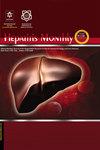槲皮素对转化生长因子-β激活的肝星状细胞系LX-2中NOX和P-Smad3C表达的影响
IF 0.6
4区 医学
Q4 GASTROENTEROLOGY & HEPATOLOGY
引用次数: 0
摘要
背景:肝星状细胞(HSCs)在肝纤维化中起主要作用。NOXs是肝脏中活性氧(ROS)的主要来源。其中,NOX1、NOX2、NOX4在hsc中表达较多,参与肝纤维化的发生。槲皮素是一种丰富的柑橘类黄酮,已知对肝损伤和肝纤维化有有益作用。目的:研究槲皮素对人肝LX2细胞株NOX1、NOX2、NOX4表达及TGF-β诱导的Smad3磷酸化的影响。方法:采用MTT法测定槲皮素对细胞的细胞毒作用。用2 ng/mL的TGF-β活化细胞24 h,然后用不同浓度的槲皮素处理。采用实时聚合酶链反应(PCR)和western blot方法分析NOX1、NOX2、NOX4和磷酸化Smad3C (p-Smad3C) mRNA的表达率。结果:TGF-β增加LX2细胞株NOX1、NOX2、NOX4 mRNA表达及p-Smad3C蛋白水平。槲皮素显著降低LX-2细胞中NOX1、NOX2和NOX4 mRNA的表达。槲皮素还能显著降低TGF-β激活的LX-2细胞株的p-Smad3C水平。结论:槲皮素可能通过降低活化hsc中NOX1、NOX2和NOX4的表达而有效改善肝纤维化。槲皮素降低这些靶基因表达的主要机制可能与降低p-Smad3C水平有关。本文章由计算机程序翻译,如有差异,请以英文原文为准。
Effect of Quercetin on the Expression of NOXs and P-Smad3C in TGF-Β-Activated Hepatic Stellate Cell Line LX-2
Background: Hepatic stellate cells (HSCs) play a primary role in liver fibrogenesis. NOXs are the main origin of reactive oxygen species (ROS) in the liver. Among them, NOX1, NOX2, and NOX4 are expressed more in HSCs and are involved in the development of liver fibrosis. Quercetin, an abundant citrus flavonoid, is known to have beneficial effects on liver injury and hepatic fibrosis. Objectives: In this study, the effect of quercetin on NOX1, NOX2, and NOX4 expression and Smad3 phosphorylation induced by TGF-β in the human hepatic LX2 cell line was investigated. Methods: The cytotoxic effects of quercetin on the cells were determined by MTT assay. The cells were activated with 2 ng/mL of TGF-β for 24 h and then treated with different concentrations of Quercetin. The mRNA expression rates of NOX1, NOX2, NOX4, and phosphorylated Smad 3C (p-Smad3C) were analyzed using real-time polymerase chain reaction (PCR) and western blot assays. Results: TGF-β increased the mRNA expression of NOX1, NOX2, and NOX4 and the protein level of p-Smad3C in the LX2 cell line. Quercetin significantly decreased the mRNA expression of NOX1, NOX2, and NOX4 in the LX-2 cells. Moreover, quercetin significantly diminished the p-Smad3C level in the LX-2 cell line activated with TGF-β. Conclusions: Quercetin may be effective in improving hepatic fibrosis via the reduction of NOX1, NOX2, and NOX4 expression in activated HSCs. The main mechanism through which quercetin reduces the expression of these target genes may be related to the reduction of the p-Smad3C level.
求助全文
通过发布文献求助,成功后即可免费获取论文全文。
去求助
来源期刊

Hepatitis Monthly
医学-胃肠肝病学
CiteScore
1.50
自引率
0.00%
发文量
31
审稿时长
3 months
期刊介绍:
Hepatitis Monthly is a clinical journal which is informative to all practitioners like gastroenterologists, hepatologists and infectious disease specialists and internists. This authoritative clinical journal was founded by Professor Seyed-Moayed Alavian in 2002. The Journal context is devoted to the particular compilation of the latest worldwide and interdisciplinary approach and findings including original manuscripts, meta-analyses and reviews, health economic papers, debates and consensus statements of the clinical relevance of hepatological field especially liver diseases. In addition, consensus evidential reports not only highlight the new observations, original research, and results accompanied by innovative treatments and all the other relevant topics but also include highlighting disease mechanisms or important clinical observations and letters on articles published in the journal.
 求助内容:
求助内容: 应助结果提醒方式:
应助结果提醒方式:


